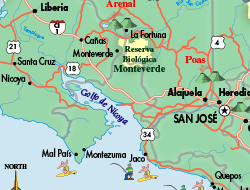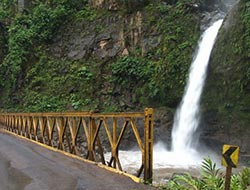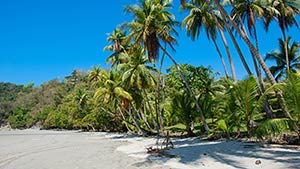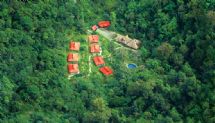Costa Rica's famous red-eyed tree frog
Red Eye Tree Frog in forest
Costa Rica, a gorgeous country bordered by Nicaragua and Panamá, is home to thousands of different plant species and Costa Rica wildlife, but perhaps none are as popular as the country's red-eyed tree frog. Locals and visits alike are always excited to get a glimpse of the gorgeous creature, making the amphibian one of the country's most popular animals.
Habitat of the Red-Eyed Tree Frog
As evidenced by their name, Costa Rica frogs live in the trees of Costa Rican rainforests. In most cases, they will spend their years in the upper parts of the trees, and in fact, these amphibians rarely touch the ground once they reach the age of maturity. The species has adapted quite well to this life, which is probably most evident in their feet. In addition to being webbed, tree frogs' feet have tiny suction cups on the bottom. These discs allow the frogs to cling to leaves without fear of falling to the ground. They also have long, sticky tongues, which makes it easier to catch food as they hop through the leaves. Most tree frogs eat insects such as moths and crickets, though some of them may also eat smaller frogs.
It's All in the Eyes
Obviously the most prominent feature of the red-eyed tree frog is its eyes. Scientifically known as Agalychnis callidryas, this amphibian's red eyes have very narrow pupils that run vertically and make for a unique appearance. The frog's body is just as eye-catching. Though mostly bright green, you can also see stripes of yellow and blue along its sides, and the feet are often orange or red. The skin on the back is thick and rough, but its belly is soft and more fragile.
Adapted for Survival
Each of these bright colors play a part in the animal's safety and well-being, but this is especially true for the eyes and feet. These excellent jumpers spend most of their days motionless among the leaves. They use their legs to cover their blue and yellow stripes and keep their eyes closed, only opening them to startle predators. When the frog senses a threat nearby, it will open its eyes wider and spread its toes to show off the color. When snakes or birds see the bright colors so prominently and unexpectedly displayed, it shocks them and slows them down, which gives the tree frog time to get to safety.
Mating Habits
Costa Rica's rainy season is when red-eyed tree frogs mate. This typically occurs during May and June. The mating ritual begins with the male frogs as they emit loud chirps that attract female suitors. After the female and male mate, she will find the underside of a leaf and deposit the fertilized eggs there. When they hatch, the tiny tadpoles fall to the ground, wiggling into the puddles that will become their homes. They will live there for about 80 days, which is the average time it takes for them to become juvenile frogs. From there, the young tree frogs will find trees and live out their lives, which are typically about five years long.
Where to View the Red-Eyed Tree Frog
Although the red-eyed tree frog lives in Mexico and throughout the rest of Central America, it is most prominent in Costa Rica, especially in its national parks. Visitors to the country who want to view these frogs in their natural habitat will want to visit one or more of these Costa Rica national parks: Monteverde Cloud Forest Reserve, Tortuguero National Park and Manuel Antonio National Park. These frogs are most active in daytime temperatures between 75 and 85 degrees Fahrenheit and nighttime temperatures between 66 and 77 degrees Fahrenheit.
7 Days / 6 Nights
Starting at $978 per person
10 Days / 9 Nights
Starting at $1,440 per person












.jpg)

.jpg)



